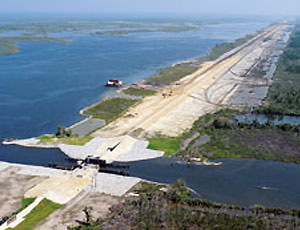The U.S. Army Corps of Engineers is to blame for massive flooding in two areas New Orleans during Hurricane Katrina in 2005 and is liable for damages sought by five plaintiffs living there, a federal court judge in New Orleans ruled Nov. 18.

The court ruled earlier that while the Corps was exempt by law from claims for damages caused by failures of flood control structures, it was not exempt from claims for damages caused by navigation works, which fall under a different law. In this case it found such damages had occurred in St. Bernard Parrish and the Lower 9th Ward as a consequence of negligent maintenance and environmental degradation of natural buffers caused by the Corps' 1965 construction and subsequent operation of the Mississippi River Gulf Outlet navigation channel. The MRGO provided a shortcut to the Gulf of Mexico along the eastern side of St. Bernard Parrish until the channel was closed earlier this year.
“The failure of the Corps to recognize the destruction that the [Mississippi River Gulf Outlet] had caused and the potential hazard that it created is clearly negligent on the part of the Corps,” says U.S. District Judge Stanwood Duval, Jr., who ruled Nov. 18 in favor of five of the six named plaintiffs and awarded $720,000 in damages.
Residents in several New Orleans neighborhoods blame the MRGO, a shipping channel constructed by the Corps in the 1950s, for acting as a conduit for devastating storm surge during the 2005 hurricane. The MRGO is also blamed for saltwater intrusion that precipitated loss of marsh that would serve as a natural buffer against storm surge.
With more than 490,000 claimants seeking recovery from the United States government for Katrina-related damages, the decision could set the stage for billions of dollars in awards and change the future of civil works construction and management, plaintiffs’ attorneys say.
The 490,000 claims “are currently the subject of litigation before the federal district court in New Orleans,” says Ken Holder, public affairs chief for the New Orleans District. “Until such time as the litigation is completed, including any appellate process, no activity is expected to be taken on any of these claims.”
The government’s defense was based on Section 702c Immunity under the Flood Control Act of 1928 and the Federal Tort Claims Act’s “due care” and discretionary function exceptions. However, Duval found that neither applies in the case of the MRGO.
“The Corps’ lassitude and failure to fulfill its duties resulted in catastrophic loss of human life and property in unprecedented proportions," Duval wrote in his ruling. “The Corps’ negligence resulted in the wasting of millions of dollars in flood protection measures and billions of dollars in Congressional outlays to help this region recover from such a catastrophe. Certainly, Congress would never have meant to protect this kind of nonfeasance on the part of the very agency that is tasked with the protection of life and property.”
In March 2008, Duval ruled that the Corps was not immune under the Flood Control Act of 1928 because the MRGO is a shipping channel, not a flood protection component. Additionally, he says the Corps’ failure to report environmental damage caused by the MRGO is a violation of the National Environmental Policy Act.
“It is the Court’s opinion that the negligence of the Corps, in this instance by failing to maintain the MRGO properly, was not policy, but insouciance, myopia and shortsightedness,” Duval wrote in his opinion. “For over forty years, the Corps was aware that the Reach II levee protecting Chalmette and the Lower Ninth Ward was going to be compromised by the continued deterioration of the MRGO....The Corps had an opportunity to take a myriad of actions to alleviate this deterioration or rehabilitate this deterioration and failed to do so.”
The Dept. of Justice is expected to appeal the decision to the U.S. 5th Circuit Court of Appeals and, if necessary, to the U.S. Supreme Court. “The government is reviewing Judge Duval’s decision,” says DOJ spokesman Charles Miller.
Contractor concern over indemnity was a huge problem in the litigious, immediate aftermath of Hurricane Katrina and remains a challenge in the ongoing Corps efforts to bring the Greater New Orleans Hurricane and Storm Damage Risk Reduction System to 100-year levels by 2011. “A number of firms were very reluctant, thinking they would get sued for the final project not working properly,” says Charlie Hess, senior vice president of operations for Shaw Environmental and Infrastructure, contractor on the $1.3 billion Inner Harbor Navigation Canal storm surge barrier. “The challenge with dealing with hurricane protection is you can never eliminate risk. You can’t guarantee a perfect reduction of risk.”

